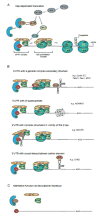Targeting RNA helicases in cancer: The translation trap
- PMID: 28965870
- PMCID: PMC5675762
- DOI: 10.1016/j.bbcan.2017.09.006
Targeting RNA helicases in cancer: The translation trap
Abstract
Cancer cells are reliant on the cellular translational machinery for both global elevation of protein synthesis and the translation of specific mRNAs that promote tumor cell survival. Targeting translational control in cancer is therefore increasingly recognized as a promising therapeutic strategy. In this regard, DEAD/H box RNA helicases are a very interesting group of proteins, with several family members regulating mRNA translation in cancer cells. In this review, we delineate the mechanisms by which DEAD/H box proteins modulate oncogenic translation and how inhibition of these RNA helicases can be exploited for anti-cancer therapeutics.
Keywords: DDX; DDX3; RNA helicase; Translation; eIF4A.
Copyright © 2017 Elsevier B.V. All rights reserved.
Conflict of interest statement
Venu Raman have received a patent for the use of RK-33 as a radiosensitizer (US8,518,901).Venu, Raman and Paul van Diest have received a patent for the use of DDX3 as a cancer biomarker (US9,322,831). Paul van Diest and Venu Raman are on the advisory board of Natsar Pharmaceuticals.
Figures




Similar articles
-
Transcriptome-wide characterization of the eIF4A signature highlights plasticity in translation regulation.Genome Biol. 2014;15(10):476. doi: 10.1186/s13059-014-0476-1. Genome Biol. 2014. PMID: 25273840 Free PMC article.
-
eIF4B stimulates translation of long mRNAs with structured 5' UTRs and low closed-loop potential but weak dependence on eIF4G.Proc Natl Acad Sci U S A. 2016 Sep 20;113(38):10464-72. doi: 10.1073/pnas.1612398113. Epub 2016 Sep 6. Proc Natl Acad Sci U S A. 2016. PMID: 27601676 Free PMC article.
-
Selective targeting of the DEAD-box RNA helicase eukaryotic initiation factor (eIF) 4A by natural products.Nat Prod Rep. 2020 May 1;37(5):609-616. doi: 10.1039/c9np00052f. Epub 2019 Nov 29. Nat Prod Rep. 2020. PMID: 31782447 Review.
-
Rocaglates convert DEAD-box protein eIF4A into a sequence-selective translational repressor.Nature. 2016 Jun 23;534(7608):558-61. doi: 10.1038/nature17978. Epub 2016 Jun 15. Nature. 2016. PMID: 27309803 Free PMC article.
-
Yeast RNA helicases of the DEAD-box family involved in translation initiation.Biol Cell. 2003 May-Jun;95(3-4):157-67. doi: 10.1016/s0248-4900(03)00032-7. Biol Cell. 2003. PMID: 12867080 Review.
Cited by
-
The In Silico Identification of Potential Members of the Ded1/DDX3 Subfamily of DEAD-Box RNA Helicases from the Protozoan Parasite Leishmania infantum and Their Analyses in Yeast.Genes (Basel). 2021 Feb 1;12(2):212. doi: 10.3390/genes12020212. Genes (Basel). 2021. PMID: 33535521 Free PMC article.
-
DDX43 mRNA expression and protein levels in relation to clinicopathological profile of breast cancer.PLoS One. 2023 May 18;18(5):e0284455. doi: 10.1371/journal.pone.0284455. eCollection 2023. PLoS One. 2023. PMID: 37200388 Free PMC article.
-
mRNA structural elements immediately upstream of the start codon dictate dependence upon eIF4A helicase activity.Genome Biol. 2019 Dec 30;20(1):300. doi: 10.1186/s13059-019-1901-2. Genome Biol. 2019. PMID: 31888698 Free PMC article.
-
Translation Initiation Machinery as a Tumor Selective Target for Radiosensitization.Int J Mol Sci. 2021 Oct 1;22(19):10664. doi: 10.3390/ijms221910664. Int J Mol Sci. 2021. PMID: 34639005 Free PMC article. Review.
-
DEAD-box RNA helicases with special reference to p68: Unwinding their biology, versatility, and therapeutic opportunity in cancer.Genes Dis. 2022 Mar 21;10(4):1220-1241. doi: 10.1016/j.gendis.2022.02.008. eCollection 2023 Jul. Genes Dis. 2022. PMID: 37397539 Free PMC article. Review.
References
-
- Kandoth C, McLellan MD, Vandin F, Ye K, Niu B, Lu C, Xie M, Zhang Q, McMichael JF, Wyczalkowski MA, Leiserson MD, Miller CA, Welch JS, Walter MJ, Wendl MC, Ley TJ, Wilson RK, Raphael BJ, Ding L. Mutational landscape and significance across 12 major cancer types. Nature. 2013;502:333–339. - PMC - PubMed
-
- Derenzini M, Montanaro L, Trere D. What the nucleolus says to a tumour pathologist. Histopathology. 2009;54:753–762. - PubMed
Publication types
MeSH terms
Substances
Grants and funding
LinkOut - more resources
Full Text Sources
Other Literature Sources
Miscellaneous

